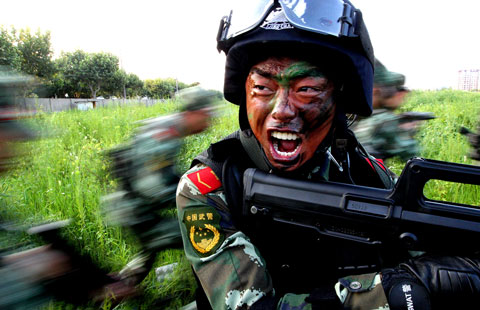
The People's Liberation Army has developed its first large-scale computer system for battle simulations, commonly known as war-gaming.
The system, launched in 2007, was created at the PLA's National Defense University and has been used so far to evaluate 22 large military operations.
It has also won 20 awards from the government and the PLA. The university is preparing to develop a second-generation system.
Song Guangfeng, logistics chief at a PLA navy submarine base, approved of the simulations.
"The war-gaming system enables us to be more combat-ready by putting us on a realistic battlefield scene," Song said.
The latest simulation, conducted on June 25, focused on logistics in a hypothetical, large-scale joint combat scenario.
Nearly 10,000 officers and senior commanders from the PLA have taken part in simulated exercises, according to Hu Xiaofeng, a professor at the university and the system's chief designer.
During development, Hu and his team visited and talked with hundreds of high-ranking officers to hear their suggestions and understand their perspectives.
Because this was a first in China, the developers had to overcome numerous obstacles. They managed to resolve key technology issues in 10 important areas, Hu said.
Professor Wu Lin, a collaborator on the project, said his team spent two and a half months conducting some 3,000 computer experiments to establish precise data on the destructive force of a single weapon.

Nearly 1,000 researchers from 30 Chinese institutes contributed to development, Hu said. They collected more than 10 million pieces of information on military operations and wrote tens of millions of lines of code.
"I told the young researchers on my team that if a mistake is made in producing a plane, you lose an aircraft. But if this system has an error, it will lead to misjudgments by commanders who will then possibly lose 10 aircraft or even a whole battle," Hu said. "So we can't afford a single mistake."
The developers decided that the system must reflect the real capabilities of the PLA and be able to mimic realistic warfare.
A computer-aided simulator was first used to assist military training in the early 1980s, and the armed forces of the United States, for example, typically run simulations before commencing real operations. Simulations were done before the Iraq War in 2003, and before Operation Neptune Spear in 2011, which killed Osama bin Laden, Hu said.
In November 2010, the trial version of China's system was finished and put to the test by 500 officers studying at National Defense University. An 11-day war game proved its reliability and demonstrated a range of capabilities.
Since then, the system has been offered to several military commands. Nearly 20 percent of its functions have been improved through users' feedback, Hu said.
"Battlefield simulation systems have been used for a long time by Western militaries," said Wu Peixin, a military analyst in Beijing. "It represents the most avant garde trend in combat training because it features low cost, high efficiency and a high degree of realism."
(China Daily 07/02/2014 page3)








